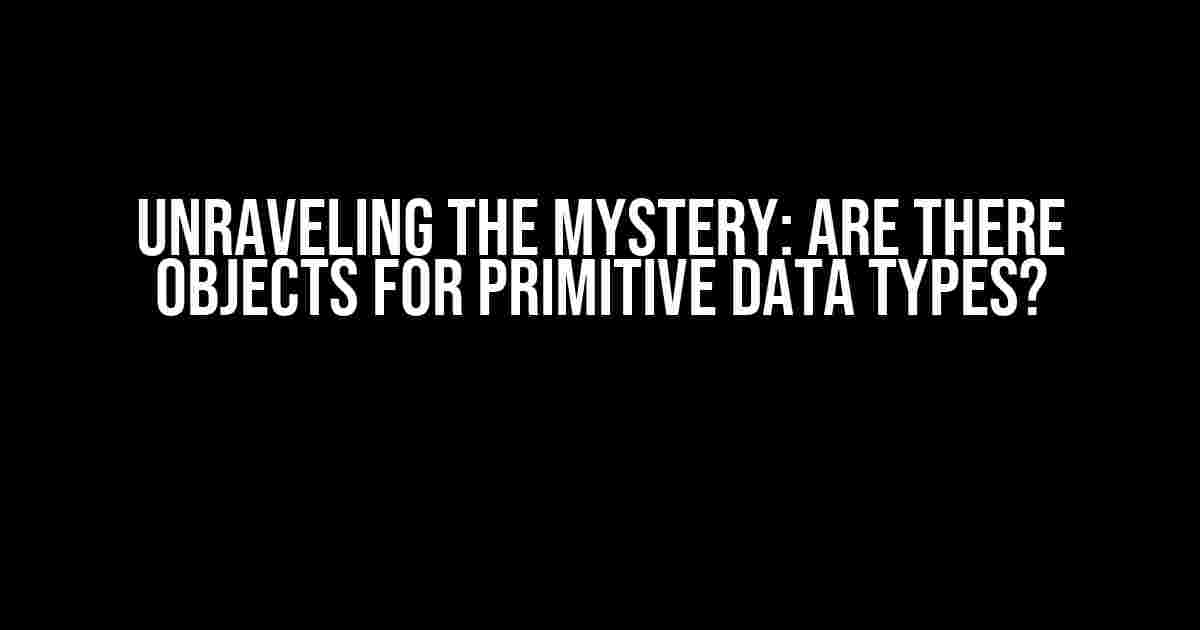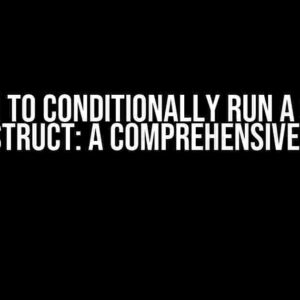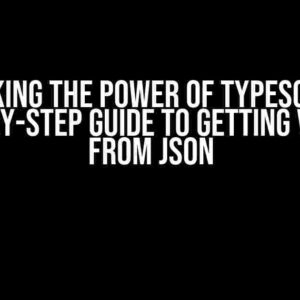As developers, we’ve all been there – scratching our heads, trying to wrap our minds around the intricacies of programming languages. One question that often leaves us perplexed is: Are there objects for primitive data types? In this article, we’ll embark on a journey to uncover the truth behind this intriguing question, and by the end of it, you’ll be equipped with a deep understanding of the concept.
Primitive Data Types: A Quick Refresher
- Boolean (true/false)
- Character (single character or symbol)
- Integer (whole number, e.g., 1, 2, 3)
- Float (decimal number, e.g., 3.14)
- String (sequence of characters, e.g., “hello world”)
The Object Conundrum
In object-oriented programming (OOP), an object is an instance of a class, which represents a real-world entity or concept. Objects have properties and methods that describe and define their behavior. Primitive data types, on the other hand, are not objects in the classical sense. So, the question remains: Are there objects for primitive data types?
The Answer: It Depends
Yes, you read that right! The answer is not a straightforward yes or no. It depends on the programming language and its implementation. Let’s explore this further:
Wrapper Classes: A Solution?
In languages like Java and C#, primitive data types are not objects, but they can be wrapped in objects. This is achieved through the use of wrapper classes, which provide a way to treat primitive data types as objects. For example:
// Java example
Integer myInt = new Integer(5);
Boolean myBool = new Boolean(true);
// C# example
int myInt = 5;
object obj = myInt; // boxing
In the above examples, the primitive data types `int` and `boolean` are wrapped in the `Integer` and `Boolean` classes, respectively. This allows us to use them as objects, complete with their own set of methods and properties.
Autoboxing and Unboxing
In some languages, like Java and C#, there’s a process called autoboxing and unboxing. Autoboxing is the automatic conversion of a primitive data type to its corresponding wrapper class, while unboxing is the reverse process. This eliminates the need for explicit wrapping and unwrapping, making it easier to work with primitive data types as objects:
// Java example
int myInt = 5;
Integer obj = myInt; // autoboxing
// C# example
int myInt = 5;
object obj = myInt; // boxing
int unboxedInt = (int)obj; // unboxing
Primitive Data Types as Objects in Other Languages
In languages like Python, Ruby, and JavaScript, primitive data types are often treated as objects by default. For example:
# Python example
my_int = 5
print(my_int.__class__) # Output:
# JavaScript example
let myNum = 5;
console.log(typeof myNum); // Output: "number"
# Ruby example
my_int = 5
puts my_int.class # Output: Integer
In these languages, primitive data types are often implemented as objects, which provides a unified way of working with data. This eliminates the need for wrapper classes or autoboxing/unboxing.
Conclusion: Are there objects for primitive data types?
In conclusion, the answer to the question “Are there objects for primitive data types?” is a resounding “it depends.” While primitive data types are not objects in the classical sense, they can be treated as objects through the use of wrapper classes, autoboxing, and unboxing in languages like Java and C#. In other languages, like Python, Ruby, and JavaScript, primitive data types are often implemented as objects by default.
As developers, it’s essential to understand the intricacies of our chosen programming languages. By recognizing the differences in how primitive data types are handled, we can write more efficient, effective, and maintainable code.
Additional Resources
If you’re interested in learning more about the topic, here are some additional resources:
- Java Autoboxing and Unboxing
- C# Boxing and Unboxing
- Python Standard Data Types
- Ruby Object Class
- JavaScript Data Structures
| Language | Primitive Data Types as Objects |
|---|---|
| Java | Through wrapper classes and autoboxing/unboxing |
| C# | Through wrapper classes and autoboxing/unboxing |
| Python | Yes, by default |
| Ruby | Yes, by default |
| JavaScript | Yes, by default |
We hope this article has provided you with a comprehensive understanding of the topic. Remember, the journey to mastering programming languages is lifelong, and there’s always more to learn.
What’s your take on this topic? Do you have any questions or experiences to share? Let us know in the comments below!
Happy coding!
Frequently Asked Question
In the world of programming, understanding data types is crucial. But have you ever wondered, are there objects for primitive data types?
What are primitive data types?
Primitive data types are basic building blocks of data in programming languages, including integer, float, boolean, char, etc. They are the fundamental types that cannot be broken down further into simpler components.
Are primitive data types objects?
No, primitive data types are not objects in most programming languages, including Java, C#, and C++. They are raw values that do not have properties or methods like objects do.
What about in JavaScript?
In JavaScript, primitive data types like numbers, strings, and booleans are not objects in the classical sense, but they do have properties and methods that can be accessed using the wrapper objects Number, String, and Boolean.
Can I use primitive data types like objects?
While you can’t use primitive data types as objects in the classical sense, many programming languages provide wrapper classes or autoboxing that allows you to use primitive types like objects, but this is still not the same as working with true objects.
When should I use primitive data types?
Use primitive data types when you need to optimize performance, reduce memory usage, or work with low-level system resources. They are also suitable for simple variables that don’t require complex behavior or manipulation.




